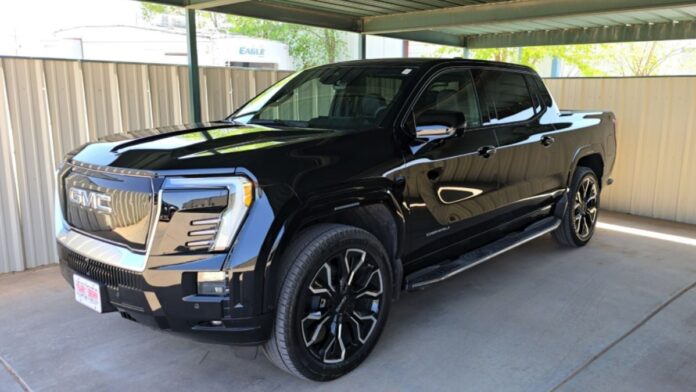Follow us today…
When we picture the modern EV revolution, our minds might go to sleek sedans, high-tech dashboards, or city commutes. But it’s out on the backroads and highways of Texas where the real proving ground lies, and that’s what made a recent post stand out to me today. While browsing the “GMC Sierra EV Group,” I came across a story shared by Dan Wilsford that gets straight to what matters: real-world performance. In just one month, Dan has driven his brand-new GMC Sierra Denali EV across state lines and towed a Can-Am HD10 over 1,200 miles to a clay shoot in San Antonio. And according to him, the truck pulled “like a rocket” the entire way.
Here’s his words: “I have had my Denali for about a month. We drove about 1,400 miles from Texas to Oklahoma and then to Kansas and back home. Then to try its towing abilities, I pulled a CanAm HD10 1,200 miles for a clay shoot in San Antonio. The truck tows like a rocket. I was blessed enough to only drop the trailer at two of the charging stops. Learning the charge stops for travel is a learning process, but I absolutely love the truck so far!”
Towing a Can-Am 1,200 Miles
There’s something inherently satisfying about pushing a new vehicle to its limits and coming out impressed. For Dan, that moment came when he hooked up his Can-Am HD10 and towed it across a couple states. While EV skeptics often bring up range anxiety and charge-stop logistics when it comes to towing, Dan’s results speak for themselves.
He only needed to drop the trailer at two charging stops, which is a better outcome than many might expect. It’s a strong indicator that, while planning is essential, towing with the Sierra EV isn’t as impractical as critics claim. In fact, as another real-world test demonstrated in this detailed towing review of the GMC Sierra EV, it’s proving capable of matching gas competitors in the same category.
Learning the Charging Curve
EV road trips with a trailer still require some strategy, and Dan was clear about the learning curve. “Learning the charge stops for travel is a learning process,” he said, and it’s true that unlike the gasoline world where you can refuel nearly anywhere, charging stops must be mapped out in advance when towing.
Dan still seems to have handled this gracefully though. His experience echoes a similar story where another Sierra EV owner towed a Tesla Model Y right after taking delivery, and despite range loss, they were surprised at how smooth and stable the towing experience felt. This is becoming a pattern: early Sierra EV adopters are proving that long-distance EV towing isn’t just feasible, but highly rewarding when done right.
Let’s Talk About Charging Costs
Ross Johnson chimed in under Dan’s post with a very practical follow-up question: “With such a large battery, what was your cost at the charging stops? Was it comparable to gas pricing? I found that Tesla Superchargers have gotten pretty expensive.”
Dan’s answer brought much-needed transparency to this area. “In the back roads of Texas it’s much like any gas station. Prices get higher as chargers get fewer. I found that it’s important to rely on the apps that are available to find the cost associated with charging. But sometimes you just have to pay the 73 cents a kW to charge. However, when I’m in the larger Texas cities, the Tesla chargers are the way to go. You can get it as low as 32 cents a kW. I think my maximum charging bill for one stop was $73.”
This is a critical detail. While many expect EVs to always be cheaper to run, real-world pricing depends heavily on geography and infrastructure. The Sierra EV’s enormous battery gives you range confidence, but it also means topping it off isn’t cheap in remote areas. That said, Dan’s breakdown shows it can still beat or match gas costs when you’re strategic about where you charge.
Other Owners Chime In
Dan’s post struck a chord with other fellow owners too. Leonel Rincon commented, “That’s Awesome! Beautiful Truck! I’m out of Houston and have also had my Sierra EV for about a month now. Absolutely love it so far.” His quick but enthusiastic response mirrors Dan’s tone that owners are genuinely excited about this truck.
Then there’s Bill Karrow, who added, “That’s an awesome report. I’m on the fence but hearing about this and its bi-directional ability to run your house is amazing.” His comment taps into one of the truck’s most futuristic capabilities also discussed in our very own Sierra EV deep-dive on Max range and bi-directional charging.
The ability to power your home during outages or even serve as a mobile energy bank is what separates today’s EV trucks from the pack. And while towing gets the spotlight, features like this are quietly reshaping the expectations of what a pickup should do.
So I think what stands out to me most in Dan’s story isn’t just that the Sierra EV performed well under pressure, but how naturally it seems to be fitting into real life. Whether it’s someone hauling a trailer for miles or simply navigating a road trip, owners aren’t just babying these trucks. They’re using them and they’re coming away impressed.
And sure, one could say that the weight pulled here wasn’t crazy, but we’ve seen examples in other articles I mentioned that prove its towing capability. That’s exactly what we need to see from a brand like GMC, especially as the Ultium platform takes on more of GM’s electrification future. As we track Sierra EV experiences from early delivery to 10,000-mile reports with ongoing feedback, I can say these stories are valuable not because they paint a perfect picture, but because they show an EV being used as a real truck.
Moral Takeaways and Key Lessons
EV Towing Is No Longer a Gimmick: The Sierra EV isn’t just towing well but towing consistently across long distances with minimal compromises. The notion that electric trucks can’t pull their weight is getting harder to defend with every story like Dan’s.
Charging Requires Planning: While infrastructure gaps still exist, knowing when and where to stop can turn a stressful experience into a smooth one. The use of apps and charging networks matters more than the drivetrain itself.
Charging Costs Are Variable but Manageable: Yes it’s true that some charging stations cost more than others, but strategic stops can lower your per-mile cost dramatically. That makes long EV trips financially viable even with a big battery to fill.
Real Owners Are Leading the Way: Posts like Dan’s and responses like Leonel’s and Bill’s are shaping the EV narrative in a way that specs never will. It’s stories like these that help other buyers get off the fence.
Share What You Think
What do you think of the GMC Sierra EV so far? Is it a truck you’d consider purchasing, or are there too many drawbacks for you?
And do you think charging access is improving fast enough to make EV trucks practical for more owners, or are we still in early adopter territory?
Don’t hesitate to drop your thoughts in the comments below. Real experiences and honest questions are what keep the EV conversation alive and evolving.
Aram Krajekian is a young automotive journalist bringing a fresh perspective to his coverage of the evolving automotive landscape. Follow Aram on X and LinkedIn for daily news coverage about cars.
Image Sources: The “GMC Sierra EV Group” public Facebook group.
Follow us today…


